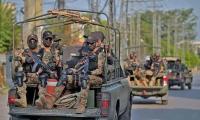Sitara-e-Shujaat, Nishan-e-Imtiaz
Before I touch into an analysis of the growth of militancy in Pakistan, it is necessary to understand the concept of militancy in its current form. The word militant comes from the 15th century Latin “militare” meaning “to serve as a solider”. The related modern concept of the militia as a defensive organisation grew out of the Anglo-Saxon “Fyrd”. Typically, a militant engages in violence as part of a claimed struggle against oppression. But the word is sometimes used to describe anyone with strongly held views (e.g., militant Christian, militant Atheist). Popular usage sometimes sees “militant” as synonymous with “terrorist”. In other words, a militant person is a confrontational person regardless of physical violence or other methods.
The term militant can describe those who aggressively and violently promote a political or their self-designed philosophy in the name of a movement (and sometimes have an extreme solution for their goal). The various movements that seek to apply militancy as a solution, or who use militancy to rationalise their solutions for issues in the modern world, seldom share common tactics. Traits shared by many militants include employing force or violence directly, either in offence or in defence, and justifying the use of force using the ideological or religious rhetoric of their particular group.
Let us discuss the roots of militancy in Pakistan, which can be traced back to many socio-political factors. Social deprivation, drug-smuggling, Afghan refugees, religious exploitation through some madaris and training centres, and external factors such as the interplay of power politics at the international level, all have had their share in spreading militancy in Pakistan.
The militants are using various strategies to destabilise the country. Scores of people have been killed in suicide bombings, although most attacks have targeted the army and police. Rallies, mosques and other locations have also been targeted. There is big question why these extremists group do so? Let us find its answer by tracing the origin of terrorism and its growth in Pakistan. It started in the decade of 1979 when the Soviet Union invaded Afghanistan with the intent of ultimately reaching to hot waters in the South, capture the oil-rich Gulf countries as well as to expand its communist ideology. Ideological conflicts between two super powers, United States and Soviet Union had already been engaged in cold war and the invasion of Afghanistan by Soviet Union provided opportunity to USA to covertly engage in guerilla war with Soviet army through local and foreign fighters. Pakistan being part of the game had to face the militancy as the aftermath of Soviet-Afghan war.
The idea of pitching Muslim fighters against Soviet Union was planned by the France because the French knew that Islamic reformers do not like the communism considering it against the Islamic ideologies and floated this idea to USA and UK claiming that Muslim fighters may act as robust force against Soviet Union. American efforts against the Soviet Union increased when Ronald Ragan became the president in 1980. United States rallied the support of Saudi Arabia and Gulf countries as well as Pakistan where Pakistan provided logistic as well as training support to these fighters whereas the Saudi Arabia developed a system to channel the funds to those ‘Mujahidin’ through Pakistan. USA used Ziaul Haq and launched operation against Soviet Union where full cooperation was witnessed between ISI and CIA. This war made more clergies in Pakistan and motivated the people in the name of Islam from the whole world, who were trained and sent to Afghanistan.
The planners of the guerrilla war recruited the fighters from the Madaris (Religious Schools) with the motivation of Jihad and encouraged the jihadist organisations or small militant groups to join the war against Soviet army. Notably amongst those militant groups was al-Qaeda led by Osama bin Laden. With the defeat and withdrawal of Soviet Union from Afghanistan, United Sates returned back to homeland and left Pakistan with these volunteer fighters. After the war, these groups joined other militant groups such as al-Qaeda – which had turned against USA – and Tehrik-e-Taliban Afghanistan and Tehrik-e-Taliban Pakistan. Unfortunately these fighters divided into different groups and engaged in sectarian clashes, kidnapping, looting and target killing. Punjabi Taliban also joined hands with TTP and Lashkar-e-Jhangvi and TTP started working more closely with al-Qaeda. The so-called Jihadists kept on multiplying. They started emerging as a force and the entire training and trained fighters named themselves as Taliban and these jobless fighters started to fight the state of Pakistan. Pakistan started suffering in their hands and we witnessed the transformation of al-Qaeda led by OBL duly supported by Al Zawahiri and Muslim brotherhood. The extremists from all over the world joined al-Qaeda and most of the training of these militants was done by Egyptian trainers and militants like Abdul Rehman Khaddar, Zahid Al-Sheikh, Khalid Al-Sheikh and Ramzi Yousaf emerged and we witnessed first attack on world trade centre by Yousaf Ramzi.
This did not end here as the incident of 9/11 brought a major change in the foreign policy of United States, which reshaped its security structure and its foreign policy. On the other hand, Pakistan who was supporting the Taliban government as legitimised government also took the major shift in its foreign policy, after the Bush administration took a rigid stance of “with us or against us”. Pakistan was left with no other option but to join the war on terror of USA against Taliban and al-Qaeda, which ultimately earned animosity of Taliban and its allied militant groups including al-Qaeda. In a bid to secure pleasure of USA, Gen. Musharraf opted to fell in the second trap set by USA. This action by Gen. Pervez Musharraf declaring the war against Taliban by joining the war on terror against the jihadist organisations prompted the terrorist organisations and the Taliban to declare war against the Pakistan government and those who were supporting the West agenda. Pakistan is paying very happy price of this cooperation with USA. USA by using logistics from Pakistan made its foot hold very strong by installing its own puppet governments of President Karzai and President Ashraf Ghani. A wave of extreme terrorism started in Pakistan and resultantly we have suffered economic loss of Pakistan $68 billion since 2001 to 2012 but now it has reached up to $90 billion as Pakistan was forced into this war. This war spread throughout the country especially in the Fata and Swat, which witnessed huge increase in militancy in Pakistan.
Ethnic and sectarian divide is being promoted by India and Afghanistan and it has yet become source of extremism in the country. Sectarian terrorism has affected all parts of the country but its sporadic strikes are mostly present in the northern and southern areas of Punjab, posing a real threat to the national security of the country.
Let us examine the factors promoting terrorism and manipulating our youth. Three factors provide fresh recruits to militant networks. Firstly, the textbooks taught in schools and colleges. Secondly, brainwashing in some madaris or seminaries, which inculcate extremist thinking. Thirdly, unhindered flows of hate material through videos, audios and the continuous misuse of loudspeakers in mosques.
Madaris are the second fountainhead of extremist thinking. They have produced almost the entire leadership of the TTP. Some of the top Afghan Taliban are the alumnus of Pakistani seminaries. Gulf countries funded many Madaris. These seminaries were used in creating anti-Shia sentiment in Pakistan. In fact, hundreds of new madaris were set up during Ziaul Haq’s eleven-year rule with foreign assistance.
Audio/video elements: The third source of extremism is the freely available audio and video material fanning sectarian hatred. Some prayer leaders who were educated in these seminaries and known for spreading hatred, continued their mission.
How can we bring end to the terrorism in Pakistan? The wave of terrorism Pakistan and the wider region is facing cannot alone be defeated through military operations. With its multinational reach and goals, terrorism can only be truly eradicated if countries in the region – mainly Pakistan, Afghanistan and India – come together and cooperate. In the last 16 years, scores of terror attacks have killed about 61,700 people in Pakistan. Military operations, particularly Zarb-e-Azb, have reduced violent incidents by over 65 per cent but the threat still looms, as witnessed in February, which saw a string of bombings in different parts of the country. The newly launched operation Raddul-Fasaad is likely to further reduce terror-related violence in Pakistan but cannot eliminate it completely.
The military actions may have crushed the radicalised terrorists but it cannot defeat the extreme ideology of the terrorists, which keep on grooming a new breed of radicalised people. The phenomenon of radicalisation of people needs to be taken seriously at government level if it was serious in combating the extreme ideology. The government needs to:
(a) Vigorously follow the Madaris Reforms initiated by PPP government, ensuring that the religious seminaries are no more breading grounds for radicalisation of its students. The agreement between the government and ITMP, inter alia provided for (a) five boards of ITMP to be linked with Ministry of Education; (b) no madrasa shall teach or publish any literature, which promotes militancy or spreads sectarianism; and (c) foreign students registration would be regulated through Ministry of Interior; (b) Besides, a de-radicalisation programme, to be run, nationally in general, by reputable psychologists needs to be initiated and put in operation; (c) Similar programme may be designed to run inside jails for those terrorists who are already under custody as well as for general public of the jails; (d) A counter-narrative supported by valid sources of religion must be developed and propagated widely to counter the extreme ideologies of the terrorists and radicalised people in the country; (e) An option of general amnesty for foot soldiers may be considered with promise of job opportunities and financial assistance. Needless to remind that those prepared to shun off their extreme ideology and violence may go back if these promises are not fulfilled; and, (f) Most importantly, a truth and reconciliation Commission may be set up to identify the areas where the State and the successive governments had gone wrong and actively or passively created circumstances favourably to breed and flourish militancy/terrorism in the country.
The militancy in Afghanistan is, in fact, inspiring militancy in Pakistan. The current volatile political and security situation in our neighbouring country in no way in the interest of Pakistan. It is a stated stand of Pakistan that stable and peaceful Afghanistan is in the interest of Pakistan and it is ready and willing to work with Afghanistan to achieve this goal. However, the only way to curb the menace of militancy and terrorism across the borders of both the country lies in close cooperation vis-à-vis border management, which would refuse terrorists/militants to move between both the countries thus containing their operational activities. Both the countries have to refuse the terrorists and any third party to use their soils against each other.
The growing presence of Daesh in Afghanistan and its terrorist activities inside Afghanistan and in Pakistan is another worrisome factor for both the countries and if both the countries did not act jointly to contain its tentacles then it may emerge as another monster in the region. In such a situation, cooperation between regional countries on counterterrorism seems likely the obvious strategy and it is the need of the day that these countries work closely to prevent growing and spreading of militancy in the region, in particular, and in the world, in general.
The writer is Chairman of think tank "global eye" & former Interior Minister of Pakistan.
@Email: rmalik1212@gmail .com
Twitter @Senrehmanmalik , @GlobalEye_GSA, WhatsApp +923325559393
According to the CTD spokesman, the two were attempting to enter Punjab from Khyber Pakhtunkhwa
Foreign Office's silence on the US threat to impose sanctions on Pakistan for economic agreements with Iran
President Zardari express views while talking to the visiting Chairman of China International Development Cooperation...
Kundi emphasised that recent electoral outcomes indicated a public preference for parliamentary cooperation over...







